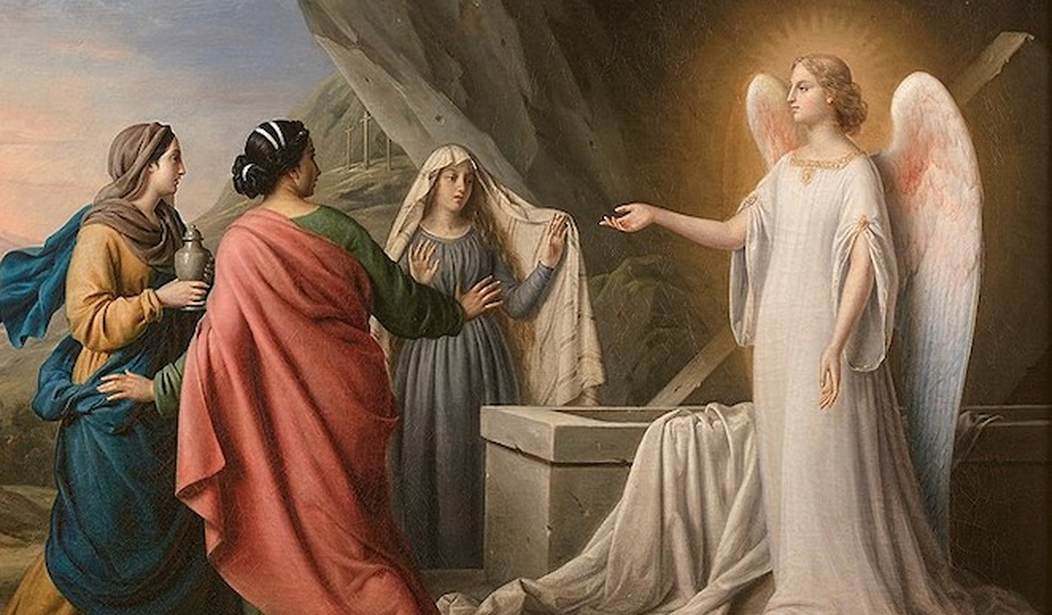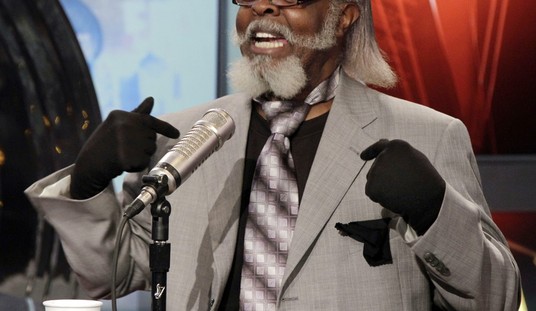May all of our readers have a happy and blessed Easter celebration today!
Tonight’s Gospel reading from the Easter Vigil is Matthew 28:1-10, when the women come across the empty tomb and are the first to be told its implications:
After the sabbath, as the first day of the week was dawning, Mary Magdalene and the other Mary came to see the tomb. And behold, there was a great earthquake; for an angel of the Lord descended from heaven, approached, rolled back the stone, and sat upon it. His appearance was like lightning and his clothing was white as snow. The guards were shaken with fear of him and became like dead men. Then the angel said to the women in reply, “Do not be afraid! I know that you are seeking Jesus the crucified. He is not here, for he has been raised just as he said. Come and see the place where he lay. Then go quickly and tell his disciples, ‘He has been raised from the dead, and he is going before you to Galilee; there you will see him.’ Behold, I have told you.”
Then they went away quickly from the tomb, fearful yet overjoyed, and ran to announce this to his disciples. And behold, Jesus met them on their way and greeted them. They approached, embraced his feet, and did him homage. Then Jesus said to them, “Do not be afraid. Go tell my brothers to go to Galilee, and there they will see me.”
Later today, we also hear the same scene from John 20:1-9, where John joins Peter at the tomb. The testimony is somewhat different, but the message the same:
On the first day of the week, Mary of Magdala came to the tomb early in the morning, while it was still dark, and saw the stone removed from the tomb. So she ran and went to Simon Peter and to the other disciple whom Jesus loved, and told them, “They have taken the Lord from the tomb, and we don’t know where they put him.” So Peter and the other disciple went out and came to the tomb. They both ran, but the other disciple ran faster than Peter and arrived at the tomb first; he bent down and saw the burial cloths there, but did not go in. When Simon Peter arrived after him, he went into the tomb and saw the burial cloths there, and the cloth that had covered his head, not with the burial cloths but rolled up in a separate place. Then the other disciple also went in, the one who had arrived at the tomb first, and he saw and believed. For they did not yet understand the Scripture that he had to rise from the dead.
Finally, we go back to Luke again (24:13-35) for the story of the road to Emmaus:
That very day, the first day of the week, two of Jesus’ disciples were going to a village seven miles from Jerusalem called Emmaus, and they were conversing about all the things that had occurred. And it happened that while they were conversing and debating, Jesus himself drew near and walked with them, but their eyes were prevented from recognizing him. He asked them, “What are you discussing as you walk along?” They stopped, looking downcast. One of them, named Cleopas, said to him in reply, “Are you the only visitor to Jerusalem who does not know of the things that have taken place there in these days?” And he replied to them, “What sort of things?”
They said to him, “The things that happened to Jesus the Nazarene, who was a prophet mighty in deed and word before God and all the people, how our chief priests and rulers both handed him over to a sentence of death and crucified him. But we were hoping that he would be the one to redeem Israel; and besides all this, it is now the third day since this took place. Some women from our group, however, have astounded us: they were at the tomb early in the morning and did not find his body; they came back and reported that they had indeed seen a vision of angels who announced that he was alive. Then some of those with us went to the tomb and found things just as the women had described, but him they did not see.”
And he said to them, “Oh, how foolish you are! How slow of heart to believe all that the prophets spoke! Was it not necessary that the Christ should suffer these things and enter into his glory?” Then beginning with Moses and all the prophets, he interpreted to them what referred to him in all the Scriptures. As they approached the village to which they were going, he gave the impression that he was going on farther. But they urged him, “Stay with us, for it is nearly evening and the day is almost over.” So he went in to stay with them. And it happened that, while he was with them at table, he took bread, said the blessing, broke it, and gave it to them. With that their eyes were opened and they recognized him, but he vanished from their sight.
Then they said to each other, “Were not our hearts burning within us while he spoke to us on the way and opened the Scriptures to us?” So they set out at once and returned to Jerusalem where they found gathered together the eleven and those with them who were saying, “The Lord has truly been raised and has appeared to Simon!” Then the two recounted what had taken place on the way and how he was made known to them in the breaking of bread.
“Why do you seek the living among the dead?”
This question comes to us in Luke 24 prior to the last reading above. The two angels greet the women who come to Jesus’ tomb with this question. The women, understandably mourning Jesus’ death on the cross, came to finish the burial ceremonies that had been rushed in the immediacy of Jesus’ death and the start of the Sabbath. They understandably wanted to tend to the dead, as they saw their task, but only because they nor any of the disciples had yet grasped Jesus’ full mission.
For us, this question should have special resonance, and not just at Easter. We already know that Christ defeated death in His resurrection on our behalf, a victory in which we share only through His grace. We do not seek Him at the tomb any longer, nor even on the cross, even as it remains a powerful symbol of His love and sacrifice. We seek Him through the Holy Spirit, which we will revere at Pentecost, the Trinitarian Person who converts our hearts into His temple — when we allow it.
Our predilection toward sin, however, leads us to seek redemption elsewhere. We seek it through our own will alone, even though we know it is an impossibility. We seek salvation through material ends — money, sex, power, gluttony, and so on. The mortal sins all relate to the same impulse of original sin: an attempt to challenge God by controlling Creation and judging good and evil without Him.
This choice led to the fall in Genesis, and that rebellion is innate within us. It is why the Word of God came as one of us, dwelt among us, and chose to become the spotless sacrifice for all our sins throughout time. His victory over death is ours — if we choose it. Instead, we find ourselves always returning to our own grave for salvation, again and again, by refusing to recognize the authority and lordship of God.
Even once we accept the Lord’s salvation and take the Holy Spirit into our hearts, though, sin tugs at us and seduces us to seek our previous life away from Him. We constantly seek ourselves among the dead in that sense, rather than seek our living selves in His salvation.
This Easter, we should ask ourselves the same question that the angels ask the women: Why do we seek the living among the dead? What is it within us that pulls us back to our ‘dead’ selves rather than our redeemed and true identities? Why do we seek salvation in the material rather than in the Lord who created it and us? The empty tomb is a powerful reminder that we will find nothing among the dead except death and hopelessness — and that Christ’s tomb points us to eternal life.
And may this Easter season light your path unto Him!
The front-page image is a detail from “The Three Women on the Tomb of Christ” by Irma Martin, 1843. Currently in a private collection. Via Wikimedia Commons.
“Sunday Reflection” is a regular feature, looking at the specific readings used in today’s Mass in Catholic parishes around the world. The reflection represents only my own point of view, intended to help prepare myself for the Lord’s day and perhaps spark a meaningful discussion. Previous Sunday Reflections from the main page can be found here.








Join the conversation as a VIP Member